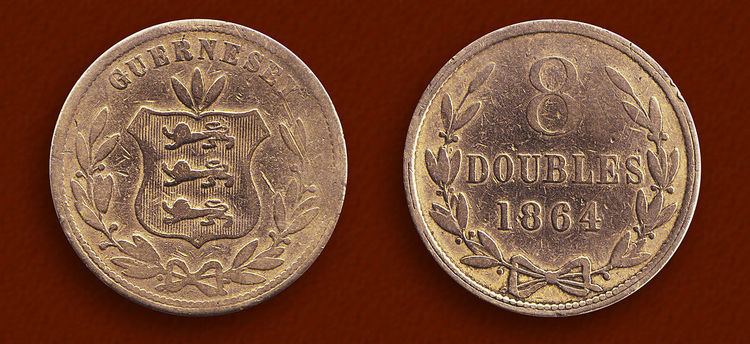Code GGP penny pence penny p | Symbol £ Banknotes £1, £5, £10, £20, £50 | |
 | ||
The pound is the currency of Guernsey. Since 1921, Guernsey has been in currency union with the United Kingdom and the Guernsey pound is not a separate currency but is a local issue of banknotes and coins denominated in pound sterling, in a similar way to the banknotes issued in Scotland and Northern Ireland (see Banknotes of the pound sterling).‹See TfD› It can be exchanged at par with other sterling coinage and notes (see also sterling zone).
Contents
For this reason, ISO 4217 does not include a separate currency code for the Guernsey pound, but where a distinct code is desired GGP is generally used.
History
Until the early 19th century, Guernsey used predominantly French currency. Coins of the French livre were legal tender until 1834, with French francs used until 1921. In 1830, Guernsey began production of copper coins denominated in doubles. The double was worth 1/80 of a French franc. The name "double" derived from the French "double deniers", although the value of the coin was equal to the liard (3 deniers piece) still circulating. Coins were issued in denominations of 1, 2, 4 and 8 doubles. The 8 double coin was a "Guernsey penny", with twelve to the "Guernsey shilling" (worth 1.2 francs). However, this shilling was not equal to the British shilling (worth 1.26 francs, as the exchange rate according to the respective gold standards was 25.22 francs = 1 pound sterling). Banknotes were also produced by the States of Guernsey from 1827, denominated in pounds. In 1848, an ordinance was passed that the pound sterling should be legal tender at a value of £1 1s 3d (2040 doubles). This was rescinded two years later and French currency, supplemented by local issues, continued to circulate. In 1870, British coins were made legal tender, with the British shilling circulating at 12½ Guernsey pence. Bank of England notes became legal tender in 1873. In 1914, new banknotes appeared, some of which carried denominations in Guernsey shillings and francs.
After the First World War, the value of the franc began to fall relative to sterling. This caused Guernsey to adopt a pound equal to the pound sterling in 1921. For amounts below 1 shilling, the conversion rate of 1 Guernsey penny (8 doubles) = 1 British penny applied, allowing the Guernsey coins to continue to circulate. For amounts above 1 shilling, an exchange rate of 21 Guernsey shillings to the pound sterling was used, applying an approximation to the pre-war exchange rate of 25.2 francs = 1 pound sterling, rather than the exact rate of 25.22. This conversion increased the value of the double from 1⁄2016 to 1⁄1920 of a pound. The World War I issues of banknotes were overstamped with the word "British" to indicate this change. New banknotes and British silver coinage circulated alongside the double coins, with 3 pence coins minted specially for Guernsey from 1956.
In 1971, along with the rest of the British Isles, Guernsey decimalized, with the pound subdivided into 100 pence, and began issuing a full range of coin denominations from ½p to 50p (£1 and £2 coins followed later).
Where the currency is accepted
The Guernsey pound, and other notes denominated in pound sterling (including those issued by the Bank of England, Scottish, Manx and Northern Irish notes and the Jersey pound) may be used in Guernsey. The Guernsey pound is legal tender only in the Bailiwick of Guernsey although it also circulates freely in Jersey but cannot be used in the UK. It can also be exchanged in other places at banks and bureaux de change.
Coins
Between 1830 and 1956, Guernsey's four coin denominations, 1, 2, 4 and 8 doubles, all carried very similar designs, with the Island's arms and name (spelled "Guernesey") on the obverse and the denomination and date on the reverse. In addition, the 8 double coins featured a wreath on both sides.
In 1956, new designs were introduced for the 4 and 8 doubles (the lower denominations were no longer issued). These featured the Island's seal and name (now given as S'Ballivie Insule de Gernereve) on the obverse with the English name, the date and the Guernsey lily on the reverse. Threepence coins were also issued from 1956, with the same obverse and a reverse featuring the Guernsey cow.
As in the UK, 5 and 10 new pence coins were introduced in 1968, followed by 50 new pence coins in 1969, before decimalization took place in 1971 and the ½, 1 and 2 new pence coins were introduced. These coins were the same size and composition as the corresponding British coins. The word "new" was dropped in 1977. The £1 coin was introduced in 1981, two years before its introduction in the UK, although the 20 pence and £2 coins were introduced at the same time as in the UK: 1982 and 1998, respectively. The thickness of the 1981 coin was significantly thinner than the modern version and the diameter also measured slightly less.
The first decimal issues continued with the same obverse as the last pre-decimal issues until 1985, when Raphael Maklouf's portrait of Queen Elizabeth II was added. Ian Rank-Broadley's portrait of the Queen has appeared since 1998. Designs on the reverses of Guernsey's decimal coins are:
